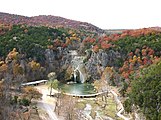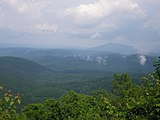Oklahoma
Oklahoma (/ˌoʊkləˈhoʊmə/ ⓘ OHK-lə-HOH-mə;[6] Choctaw: Oklahumma, pronounced [oklahómma];[7] Cherokee: ᎣᎧᎳᎰᎹ, Okalahoma, pronounced [ògàlàhǒːmã́])[8] is a landlocked state in the South Central region of the United States.[9] It borders Texas to the south and west, Kansas to the north, Missouri to the northeast, Arkansas to the east, New Mexico to the west, and Colorado to the northwest. Partially in the western extreme of the Upland South, it is the 20th-most extensive and the 28th-most populous of the 50 United States. Its residents are known as Oklahomans and its capital and largest city is Oklahoma City. The state's name is derived from the Choctaw words okla, 'people' and humma, which translates as 'red'.[10] Oklahoma is also known informally by its nickname, "The Sooner State", in reference to the Sooners, settlers who staked their claims in formerly American Indian-owned lands until the Indian Appropriations Act of 1889 authorized the Land Rush of 1889 opening the land to white settlement.
This article is about the U.S. state. For other uses, see Oklahoma (disambiguation).
Oklahoma
- Indian Territory (Independent, 1834–1907)
- Oklahoma Territory (U.S. jurisdiction, 1890–1907)
November 16, 1907 (46th)
Kevin Stitt (R)
Matt Pinnell (R)
Oklahoma Supreme Court (civil)
Oklahoma Court of Criminal Appeals (criminal)
- James Lankford (R)
- Markwayne Mullin (R)
5 Republicans (list)
69,898 sq mi (181,038 km2)
68,595 sq mi (177,660 km2)
1,304 sq mi (3,377 km2) 1.9%
468 mi (756 km)
230 mi (370 km)
1,300 ft (400 m)
4,975 ft (1,516 m)
289 ft (88 m)
4,053,824
55.20/sq mi (21.30/km2)
$50,051[2]
Oklahoman;
Okie (colloq., historically derogatory);
Sooner (historically)
Okla.
33°37' N to 37° N
94° 26' W to 103° W
With ancient mountain ranges, prairie, mesas, and eastern forests, most of Oklahoma lies in the Great Plains, Cross Timbers, and the U.S. Interior Highlands, all regions prone to severe weather.[11] Oklahoma is at a confluence of three major American cultural regions. Historically, it served as a government-sanctioned territory for American Indians moved from east of the Mississippi River, a route for cattle drives from Texas and related regions, and a destination for Southern settlers. There are currently 26 Native American languages spoken in Oklahoma.[12] According to the 2020 U.S. census, 14.2 percent of Oklahomans identify as American Indians, the highest indigenous population by percentage in any state.[13]
A major producer of natural gas, oil, and agricultural products, Oklahoma relies on an economic base of aviation, energy, telecommunications, and biotechnology.[14] Oklahoma City and Tulsa serve as Oklahoma's primary economic anchors, with nearly two-thirds of Oklahomans living within their metropolitan statistical areas.[15]
Etymology[edit]
The name Oklahoma comes from the Choctaw language phrase okla, 'people', and humma, translated as 'red'.[10][16] Choctaw Nation Chief Allen Wright suggested the name in 1866 during treaty negotiations with the federal US government on the use of Indian Territory. He envisioned an all exclusive American Indian state controlled by the United States bureau of Indian Affairs. Oklahoma later became the de facto name for Oklahoma Territory, and it was officially approved in 1890, two years after that area was opened to American settlers.[17][18][19]
In the Chickasaw language, the state is known as Oklahomma', in Arapaho as bo'oobe' (lit. 'red earth'),[20] Pawnee: Uukuhuúwa,[21] and Cayuga: Gahnawiyoˀgeh.[22]
Oklahoman English
Oklahoma
-
Germanic
- West Germanic
- Ingvaeonic
- Anglo–Frisian
- Anglic
- English
- North American English
- American English
- Southern American English
- American Inland South English
- Oklahoman English
- American Inland South English
- Southern American English
- American English
- North American English
- English
- Anglic
- Anglo–Frisian
- Ingvaeonic
- West Germanic
–
List of state symbols
- Oklahoma Rose
- Wildflower: Indian Blanket
Green and white
Waltz: Oklahoma Wind
Oklahoma Tartan
- Cartoon: Gusty created by Don Woods, Oklahoma's first professional meteorologist, used on KTUL-TV from 1954 to 1989.[321][322]
- Fruit: Strawberry[323]
- Vegetable: Watermelon[324][325]
- Game bird: Wild turkey[326]
- Monument: Golden Driller[327]
- Rock song: "Do You Realize??" by the Flaming Lips[328]
- Theater group: Lynn Riggs Players of Oklahoma[329][315]







